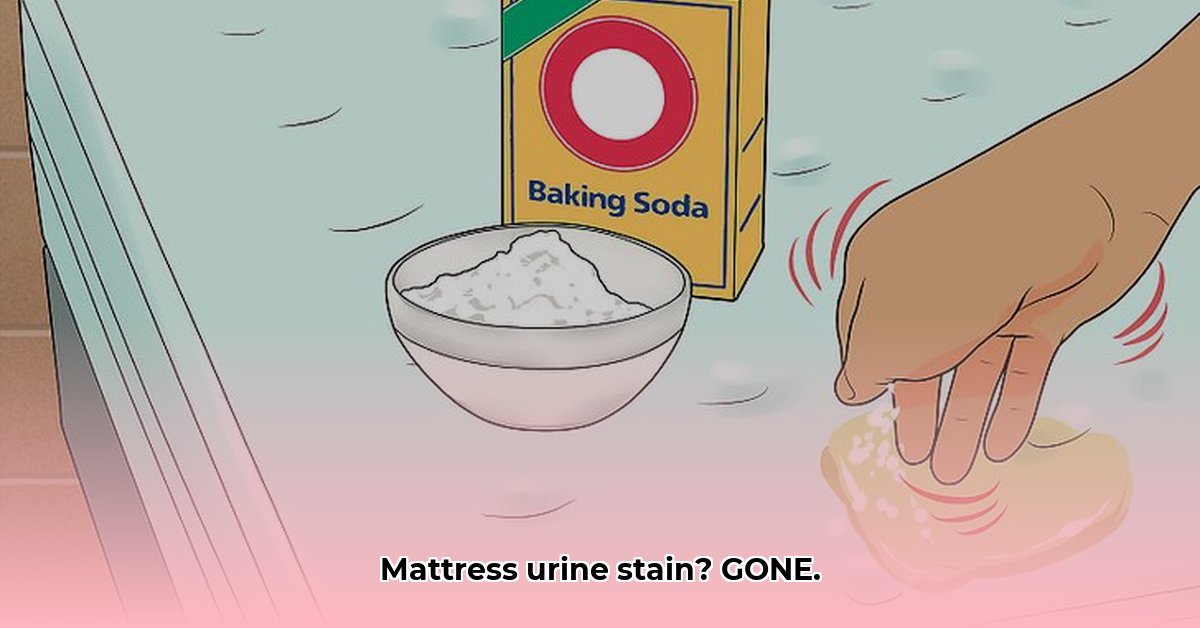Accidents happen. Whether it’s a child’s nighttime mishap, a pet’s unexpected puddle, or even your own little spill, a urine-soaked mattress can be a frustrating experience. But don’t despair! This comprehensive guide provides effective, step-by-step instructions to eliminate those stubborn stains and lingering odors, restoring your mattress to its fresh and clean state.
Understanding the Urgency: Why Act Fast?
Urine isn’t just a wet spot; it’s a complex cocktail of urea, uric acid, creatinine, and other organic compounds. These components can quickly penetrate mattress fibers, leading to discoloration, persistent odors, and even bacterial growth. Some research even connects dust mites to urine-stained areas, as these microscopic critters are attracted to the organic matter. Acting swiftly minimizes the damage and increases your chances of complete stain and odor removal.
Fresh Urine Stain Removal: A Step-by-Step Guide
The key to conquering fresh urine stains is immediate action. Here’s your battle plan:
-
Blot, Don’t Rub: Gently blot the affected area with clean, absorbent cloths or paper towels, working from the outside in. Rubbing can spread the urine and push it deeper into the mattress.
-
Vinegar Power: White vinegar is a natural deodorizer and cleaning agent. Mix equal parts white vinegar and cool water in a spray bottle. Lightly mist the stain (avoid soaking), then blot again with dry towels.
-
Baking Soda Absorption: Sprinkle a generous layer of baking soda over the damp area. Baking soda absorbs remaining moisture and traps odor-causing molecules. Let it sit for at least 8 hours, preferably overnight. Vacuum thoroughly in the morning.
Tackling Dried Urine Stains: A More Intensive Approach
Dried urine stains require a bit more effort, but they’re not unbeatable. Here are some effective strategies:
-
Enzyme Cleaners: Enzyme cleaners are specifically designed to break down organic matter like urine. Follow product instructions carefully, usually involving applying the cleaner, letting it sit, and blotting. Ongoing research continues to explore the long-term effects of enzyme cleaners on various mattress materials, so testing in an inconspicuous area first is always recommended.
-
Oxygen Bleach Paste (A Gentler Option): Mix oxygen bleach powder with warm water to create a paste. Apply to the stain and let it dry completely (this may take up to 24 hours). Vacuum any remaining residue. Always test on a hidden spot first to check for any discoloration.
-
Hydrogen Peroxide (Use with Extreme Caution): Hydrogen peroxide is a potent oxidizer that can remove stubborn stains, but it can also bleach fabrics. Always test in an inconspicuous area first. Mix 8 ounces of 3% hydrogen peroxide with 3 tablespoons of baking soda and a few drops of dish soap. Spray the mixture on the stain (never store this mixture in a closed container). Let it sit for several hours (up to 8), then blot and vacuum.
Prevention: Your Best Defense Against Mattress Mishaps
Preventing stains is always easier than removing them. Here’s how:
-
Mattress Protectors: A quality, waterproof mattress protector is an absolute must-have. It creates a barrier against liquids and other potential stains.
-
Regular Bedding Changes: Frequent washing of sheets and bedding helps maintain a clean sleep environment.
-
Air Out Your Mattress: Occasionally airing out your mattress by removing all bedding helps prevent odors and moisture buildup.
Troubleshooting: Addressing Lingering Issues
-
Lingering Odor: Repeat the baking soda treatment or use a fabric-safe odor eliminator spray.
-
Deep Stains: Consider professional mattress cleaners who have specialized equipment and expertise.
-
All-Foam Mattresses: Exercise extra caution with liquid cleaning solutions on all-foam mattresses, as they absorb liquids more readily. Blot thoroughly and allow ample drying time.
Why Removing Urine Matters: Beyond the “Ick” Factor
Urine stains aren’t just unsightly; they can impact your health and sleep. The ammonia-like smell can disrupt sleep, while bacteria and potential mold/mildew growth pose health risks, particularly for those with allergies or compromised immune systems. Additionally, urine can damage mattress materials, leading to premature wear and tear.
A Quick-Reference Guide: Mattress Stain Removal Methods
| Method | Best For | Caution |
|---|---|---|
| Blotting | Initial liquid absorption | Don’t rub! |
| Vinegar Solution | Fresh stains, odor neutralization | Test on an inconspicuous area. |
| Hydrogen Peroxide Mix | Stubborn stains, deep cleaning | Use cautiously; may bleach. Test first. |
| Baking Soda Paste/Powder | Odor absorption, residual stain treatment | Allow to dry completely before vacuuming |
| Enzyme Cleaner | Pet urine | Follow product instructions. Test in a small area. |
| Air Drying | Final drying, odor removal | Essential for all methods. |
| Mattress Protector | Preventing stains | Invest in a quality, waterproof protector |
By understanding the science behind urine stains and following these step-by-step instructions, you can effectively tackle this common household challenge and enjoy a cleaner, fresher, and healthier sleep environment. We’d love to hear your experiences and any tips you might have—share them in the comments below!










